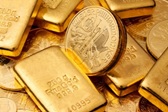How Will Terrorist Attacks in Brussels Impact the Gold Market?

 Yesterday, terrorists launched coordinated attacks across Brussels in which at least 30 people were killed and hundreds more injured. Will the attacks on the Belgian capital affect the gold market?
Yesterday, terrorists launched coordinated attacks across Brussels in which at least 30 people were killed and hundreds more injured. Will the attacks on the Belgian capital affect the gold market?
What happened?
On Tuesday, there were two suicide bomb attacks in Brussels: at Zaventem airport (at least 10 people died) and on a metro train (20 people died) close to European Union institutions. The Islamic State claimed responsibility for both of them. Some analysts link the attacks with the Friday arrest of Salah Abdeslam, the prime surviving suspect in the Islamic State’s attacks on Paris last November, although U.S. officials said the level of organization involved suggested the attacks had previously been in preparation.
Markets’ Reaction
After explosions in Brussels, the greenback rose against the euro, while the world shares fell into the red, however, they came up from their lowest levels seen in the aftermath of the attacks. The raised fears of terrorism spurred safe-haven demand both for U.S. Treasuries and gold. The price of yellow metal jumped in early U.S. trading, but it erased some of its gains later. However, it ended the U.S. session modestly higher. Indeed, the April Comex gold contract was up $3.40 at $1,247.60 an ounce. It means that we witnessed the rise of risk aversion in the marketplace, but not a panic.
Terrorist Attacks and Gold
After terrorist attacks in Paris we wrote that any positive impact would be only temporary. We have to repeat that the importance of the geopolitical concerns for the price of gold is often overstated. There is an old market saying: buy the rumor, sell the news. It means that gold is often boosted by negative geopolitical rumors, but when rumors turn into action the price of gold is often unaffected or even decreases, as this is when profit-taking begins. Alternatively, gold is boosted initially by negative events, when there is huge uncertainty what actually happened and traders buy the yellow metal just in case, but when the fears ease with the inflow of new information, the price of gold decreases. This is exactly what we witnessed after terrorist attacks in Paris.
Chart 1: Price of gold (London P.M. Fix) over the last 12 months.
As one can see in the chart above, the London P.M. gold fixing on November 16, 2015 was higher than on the day before, but it continued its downward trend started in October. The attacks in Paris did not prevent the declines, only the Fed hike in December did. The boost to safe-haven demand was short-lived (it lasted only one day).
Conclusions
To sum up, gold ended Tuesday moderately higher, however, investors should not expect a boost to safe-haven demand for the yellow metal. It is true that the attacks occurred in Brussels, near the European Union’s most important institutions, but the impact of geopolitical events on the price of gold is usually only short-lived. It does not mean that the price of gold could not continue its rally, but terrorist attacks would not be the reason behind it. There should not be spectacular safe-haven demand for gold, but terrorist attacks in Brussels may intensify fears of global terrorism and add to the long list of risk factors troubling investors, like the Fed’s monetary policy, the U.S. presidential election, the Chinese slowdown, the lack of confidence in central banks, the collapse in commodity prices, the war in Syria and nuclear threats from North Korea and Iran. In particular, the recent attacks may increase slightly the odds of Great Britain leaving the European Union (due to safety reasons) – in other words, the attacks in Brussels should not trigger a long-lasting rally in gold prices, but they may increase risk aversion at the margin and improve the long-term sentiment towards gold.
Disclaimer: Please note that the aim of the above analysis is to discuss the likely long-term impact of the featured phenomenon on the price of gold and this analysis does not indicate (nor does it aim to do so) whether gold is likely to move higher or lower in the short- or medium term. In order to determine the latter, many additional factors need to be considered (i.e. sentiment, chart patterns, cycles, indicators, ratios, self-similar patterns and more) and we are taking them into account (and discussing the short- and medium-term outlook) in our trading alerts.



















